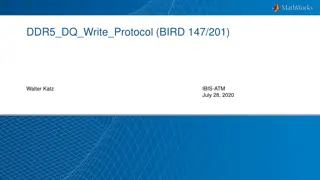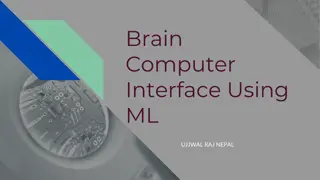
Brain-Computer Interfaces (BCI)
Discover the fascinating world of Brain-Computer Interfaces (BCI) that enable communication between the brain and machines. Explore the definition, types of BCI, components involved, advantages, disadvantages, and potential applications in various fields.
Download Presentation

Please find below an Image/Link to download the presentation.
The content on the website is provided AS IS for your information and personal use only. It may not be sold, licensed, or shared on other websites without obtaining consent from the author. If you encounter any issues during the download, it is possible that the publisher has removed the file from their server.
You are allowed to download the files provided on this website for personal or commercial use, subject to the condition that they are used lawfully. All files are the property of their respective owners.
The content on the website is provided AS IS for your information and personal use only. It may not be sold, licensed, or shared on other websites without obtaining consent from the author.
E N D
Presentation Transcript
StudyMafia.Org Brain Computer Interfaces(BCI) Submitted To: Submitted By: Studymafia.org Studymafia.org
Table Contents Definition Introduction Types of BCI Components of BCI Advantages of BCI Disadvantages of BCI Conclusion 2
Definition Brain-computer interfaces (BCI) are systems that allow communication between the brain and various machines. 3
Introduction They work in three main steps: collecting brain signals, interpreting them and outputting commands to a connected machine according to the brain signal received. BCI can be applied to a variety of tasks, including but not limited to neurofeedback, restoring motor function to paralyzed patients, allowing communication with locked in patients and improving sensory processing. 4
Types of BCI Invasive Invasive types of BCI are implanted directly into the brain during a neurosurgery. There are single unit BCIs, which detect the signal from a single area of brain cells, and multiunit BCIs which detect from multiple areas. Electrodes have different lengths, for example, up to 1.5 mm (Utah, Blackrock Microsystems) or 10 mm (FMA, MicroProbes) in a MEA. 6
Types of BCI Semi-Invasive Electrocorticography uses electrodes placed on the exposed surface of the brain to measure electrical activity from the cerebral cortex. It has been used for the first time in the 1950s at the Montreal Neurological Institute. It is called semi-invasive but it still requires a craniotomy to implant the electrodes. For this reason it is used only when surgery is necessary for medical reasons 7
Types of BCI Non Invasive There are several non-invasive techniques used to study the brain, where EEG is the most common used because of the cost and hardware portability. MEG magnetoencephalography PET positron emission tomography fMRI functional magnetic resonance imaging 8
Components of BCI Brain activity The nervous system is composed by two main parts: the central nervous system and the peripheral nervous system. The brain is the main organ of the central nervous system and it contains about 100 billions of neurons and trillions of cells called glia. 9
Components of BCI Signal acquisition In the case of EEG-BCI, the electric potential of the brain activity is measured through electrodes placed on the scalp. Electrodes are metal discs placed on the scap in positions measured using the International 10/20 system. 10
Components of BCI Preprocessing The raw EEG data is often not clean because affected by noise and artifacts. There are four main sources of noise and artifacts, which are: EEG equipment Electrical interference external to the subject and recording system The leads and electrodes The subject: electrical activity from the heart, eye blinking, eyeball movements, muscles movements in general. 11
Components of BCI Feature Extraction The next step is feature extraction: the analysis of the signal and extraction of information. As the EEG signal is very complex, it is impossible to find meaningful information just looking at it. It is needed then to apply processing algorithms which allows to find content (such as a person s intent, for example) which would be hidden at a naked eye. 12
Components of BCI Classification Another step which can be applied to the signal, now mostly clean from artifacts, is to apply classification algorithms. Using machine learning techniques it is possible to train a classifier to recognize which features, for example, belongs to one or another class. 13
Components of BCI Translation After the signal has been classified, the result is passed to the feature translation algorithm. At this point the features need to be translated in the corresponding action required. For example, a P3 potential could be translated into the selection of the letter that evoked it 14
Components of BCI Feedback device The feedback device receives the command from the translation step. For example it can be the computer, where the signal will be used to move a cursor, or it could 15
Conclusion A brain-computer interface (BCI) is a computer- based system that acquires brain signals, analyzes them, and translates them into commands that are relayed to an output device to carry out a desired action. 18
References Google.com Wikipedia.org Studymafia.org Slidespanda.com
Thanks To StudyMafia.org













